2016 YAMAHA FZS SVHO fuel
[x] Cancel search: fuelPage 44 of 106

Instrument operation
38
To switch to the voltmeter from the hour me-
ter:
Push the “Hour Volt” button for at least 1 se-
cond. The display switches to the voltmeter
from the hour meter.
EJU37272Fuel level meter
The fuel level meter shows the amount of fuel
remaining in the fuel tank. The amount of re-
maining fuel is shown using four display seg-
ments, which disappear one at a time as the
fuel level decreases.
TIP:
The accuracy of the fuel level meter varies
depending on the operating conditions. Use
this function as a reference only.
EJU37285Fuel level warning
If the fuel remaining in the fuel tank drops to
about 18 L (4.8 US gal, 4.0 Imp.gal), the low-
est fuel level segment, the fuel indicator, and
the “WARNING” indicator light blink, and the
buzzer sounds intermittently.
If the fuel level warning is activated, refill the
fuel tank as soon as possible. (See page 49
for information on filling the fuel tank.)
After the fuel tank is refilled, the warning sig-
nals will be cleared when the engine is re-
started.
TIP:
Push the “Hour Volt” button to stop the buzz-
er.
EJU37294Oil pressure warning
If the oil pressure drops significantly, the oil
pressure warning indicator and the “WARN-
ING” indicator light blink, and the buzzer
1“Hour Volt” button
2Vo l t m et e r
1Fuel level meter
1
2
1
UF3K72E0.book Page 38 Thursday, July 16, 2015 2:31 PM
Page 55 of 106

Operation and handling requirements
49
EJU31823
Fuel requirementsEJU41294Fuel
WARNING
EWJ00283
Gasoline and gasoline vapors are ex-
tremely flammable. To avoid fires and
explosions and to reduce the risk of in-
jury when refueling, follow these in-
structions.
Gasoline is poisonous and can cause in-
jury or death. Handle gasoline with care.
Never siphon gasoline by mouth. If you
should swallow some gasoline, inhale a
lot of gasoline vapor, or get some gaso-
line in your eyes, see your doctor imme-
diately. If gasoline spills on your skin,
wash with soap and water. If gasoline
spills on your clothing, change your
clothes.
NOTICE
ECJ01870
Do not use leaded gasoline. Leaded
gasoline can seriously damage the en-
gine.
Avoid getting water and contaminants in
the fuel tank. Contaminated fuel can
cause poor performance and engine
damage. Use only fresh gasoline that
has been stored in clean containers.
Use only gasoline with a minimum pump
octane number of 91 or a minimum re-
search octane number of 95. Low-oc-
tane gasoline can seriously damage the
engine.
Your Yamaha engine has been designed to
use premium unleaded gasoline with a pump
octane number [(R+M)/2] of 91 or higher, or a
research octane number of 95 or higher. Ifknocking (or pinging) occurs, use a gasoline
of a different brand.
Gasohol
There are two types of gasohol: gasohol con-
taining ethanol and that containing methanol.
Gasohol containing ethanol can be used if
ethanol content does not exceed 10% and
the fuel meets the minimum octane ratings.
E-85 is a fuel blend containing 85% ethanol
and therefore must not be used in this water-
craft. All ethanol blends containing more than
10% ethanol can cause fuel system damage
or engine performance problems.
Yamaha does not recommend gasohol con-
taining methanol because it can cause fuel
system damage and engine performance
problems.
To fill the fuel tank:
(1) Before refueling, stop the engine. Do not
stand or sit on the watercraft. Never refu-
el while smoking, or while in the vicinity
of sparks, open flames, or other sources
of ignition.
(2) Place the watercraft in a well-ventilated
area and in a horizontal position.
(3) Remove the seats, and then check the
fuel level. (See page 41 for seat removal
and installation procedures.) Recommended fuel:
Premium unleaded gasoline with a
minimum octane rating of
91
(Pump octane number) = (R + M)/2
95 (Research octane number)
UF3K72E0.book Page 49 Thursday, July 16, 2015 2:31 PM
Page 56 of 106
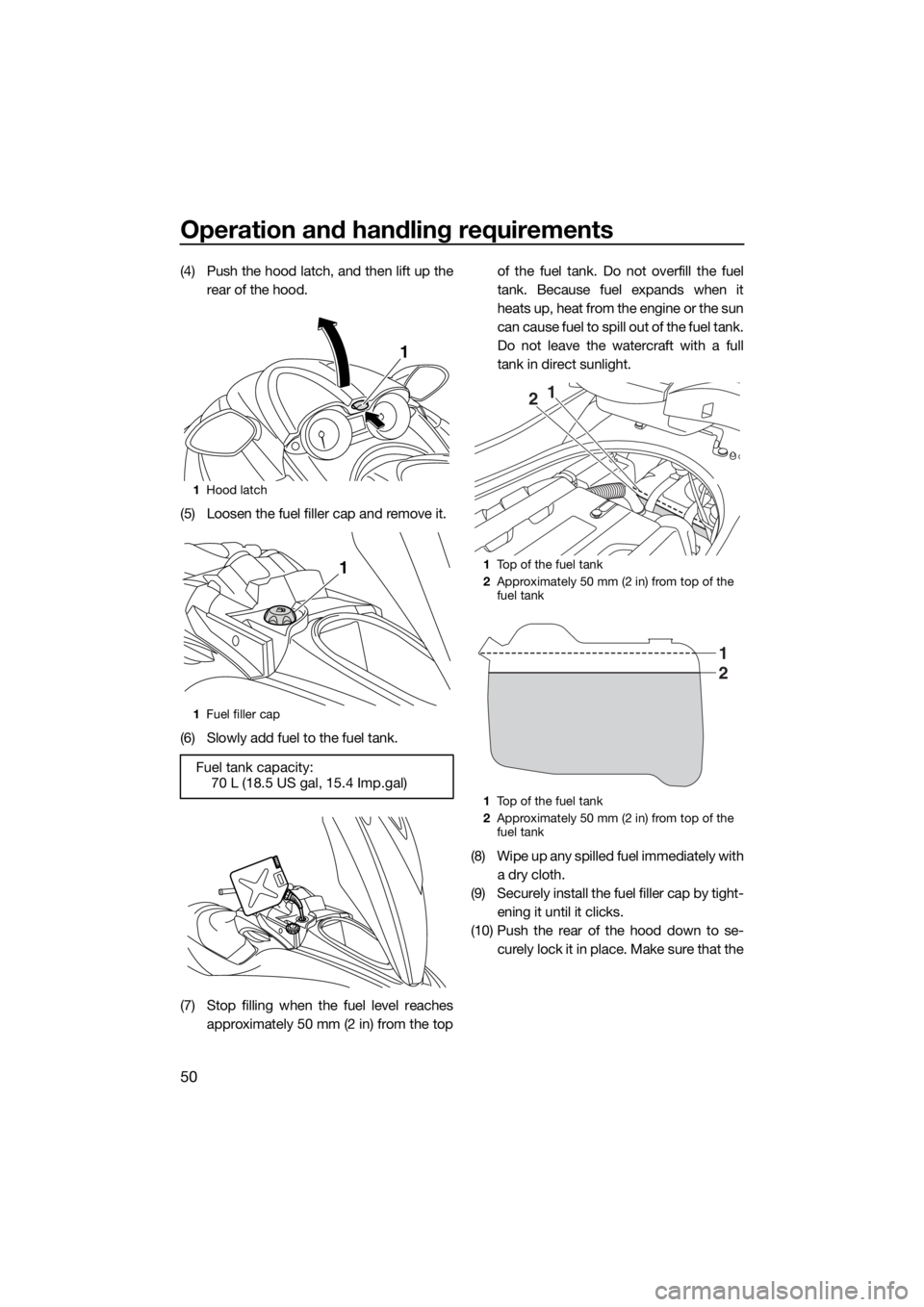
Operation and handling requirements
50
(4) Push the hood latch, and then lift up the
rear of the hood.
(5) Loosen the fuel filler cap and remove it.
(6) Slowly add fuel to the fuel tank.
(7) Stop filling when the fuel level reaches
approximately 50 mm (2 in) from the topof the fuel tank. Do not overfill the fuel
tank. Because fuel expands when it
heats up, heat from the engine or the sun
can cause fuel to spill out of the fuel tank.
Do not leave the watercraft with a full
tank in direct sunlight.
(8) Wipe up any spilled fuel immediately with
a dry cloth.
(9) Securely install the fuel filler cap by tight-
ening it until it clicks.
(10) Push the rear of the hood down to se-
curely lock it in place. Make sure that the
1Hood latch
1Fuel filler cap
Fuel tank capacity:
70 L (18.5 US gal, 15.4 Imp.gal)
1
11Top of the fuel tank
2Approximately 50 mm (2 in) from top of the
fuel tank
1Top of the fuel tank
2Approximately 50 mm (2 in) from top of the
fuel tank
1
2
1
2
UF3K72E0.book Page 50 Thursday, July 16, 2015 2:31 PM
Page 57 of 106
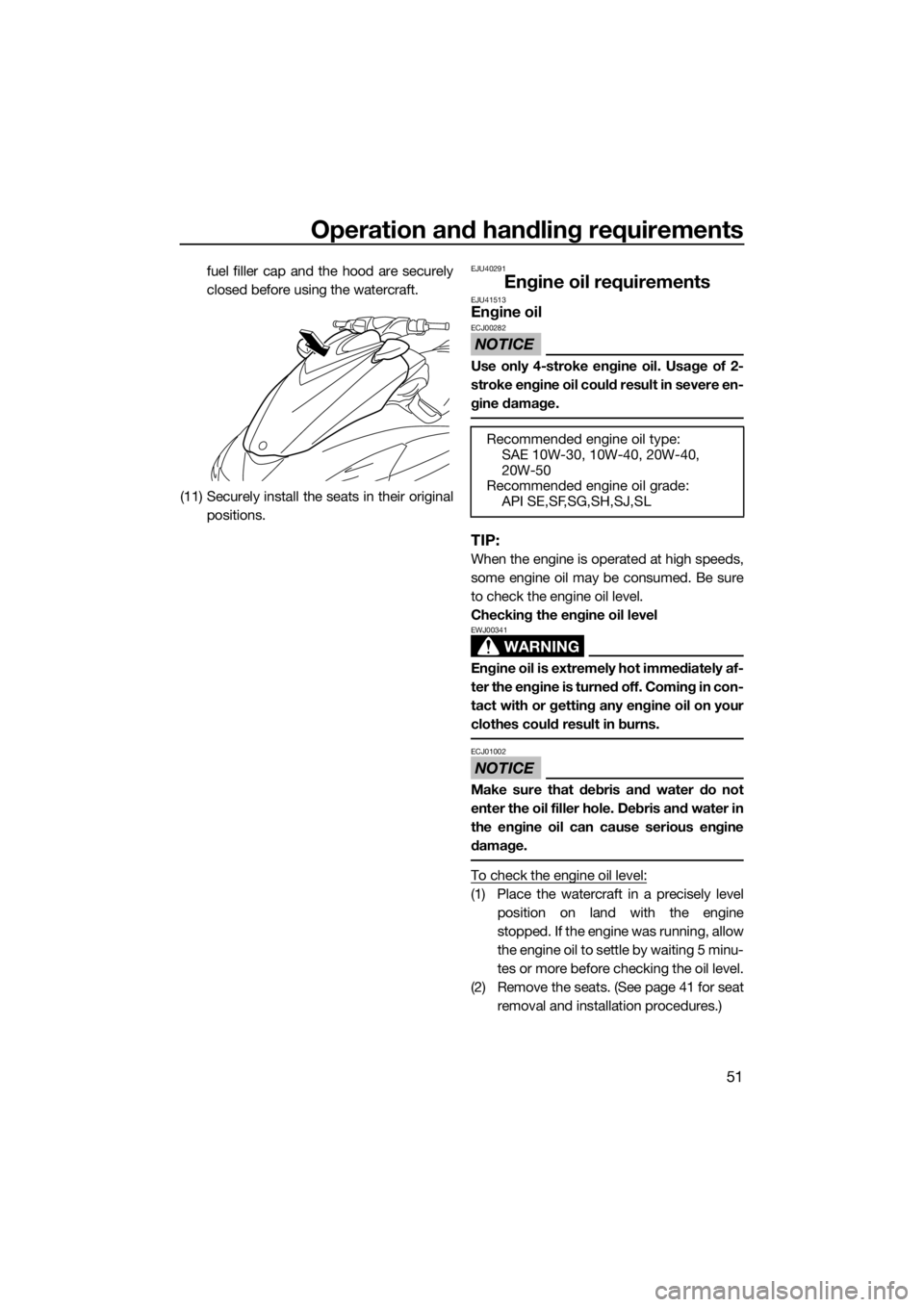
Operation and handling requirements
51
fuel filler cap and the hood are securely
closed before using the watercraft.
(11) Securely install the seats in their original
positions.EJU40291
Engine oil requirementsEJU41513Engine oil
NOTICE
ECJ00282
Use only 4-stroke engine oil. Usage of 2-
stroke engine oil could result in severe en-
gine damage.
TIP:
When the engine is operated at high speeds,
some engine oil may be consumed. Be sure
to check the engine oil level.
Checking the engine oil level
WARNING
EWJ00341
Engine oil is extremely hot immediately af-
ter the engine is turned off. Coming in con-
tact with or getting any engine oil on your
clothes could result in burns.
NOTICE
ECJ01002
Make sure that debris and water do not
enter the oil filler hole. Debris and water in
the engine oil can cause serious engine
damage.
To check the engine oil level:
(1) Place the watercraft in a precisely level
position on land with the engine
stopped. If the engine was running, allow
the engine oil to settle by waiting 5 minu-
tes or more before checking the oil level.
(2) Remove the seats. (See page 41 for seat
removal and installation procedures.)
Recommended engine oil type:
SAE 10W-30, 10W-40, 20W-40,
20W-50
Recommended engine oil grade:
API SE,SF,SG,SH,SJ,SL
UF3K72E0.book Page 51 Thursday, July 16, 2015 2:31 PM
Page 62 of 106

Pre-operation checks
56
EJU31982
WARNING
EWJ00412
Failure to inspect or maintain the watercraft properly increases the possibility of an ac-
cident or damage to the watercraft. Do not operate the watercraft if you find any prob-
lem. If a problem cannot be corrected by the procedures provided in this manual, have
the watercraft inspected by a Yamaha dealer.
EJU41234Pre-operation checklist
Before using this watercraft, be sure to perform the checks in the following checklist.
ITEM ROUTINE PAGE
PRE-LAUNCH CHECKS
Engine compartmentVentilate the engine compartment.
Check inside the engine compartment for damage.58
Fuel systemCheck the fuel system for leakage.
Check the fuel level in the fuel tank.58
Water separatorCheck the water separator for water. 58
Engine unitCheck the exterior of the engine unit for damage. 59
Engine oil levelCheck the engine oil level. 59
Bilge waterCheck the engine compartment for bilge water. 59
BatteryCheck the battery connections and electrolyte level. 59
Steering systemCheck the steering system for proper operation. 60
Telescopic steering systemCheck the telescopic steering system for proper op-
eration and check that the handlebars are securely
locked in place.61
Q.S.T.S.Check the Q.S.T.S. for proper operation and check
that the Q.S.T.S. selector is securely locked in pla-
ce.61
Reverse systemCheck the reverse system for proper operation. 62
Throttle leverCheck the throttle lever for proper operation.
Check the throttle lever free play.62
Remote control transmitterCheck the remote control transmitter for proper op-
eration.63
Engine shut-off cord (lan-
yard)Check the engine shut-off cord (lanyard) for dam-
age.63
SwitchesCheck the start switch, engine stop switch, and en-
gine shut-off switch for proper operation.63
Storage compartmentsCheck the storage compartments for damage and
water.64
Fire extinguisher holder,
cover, and bandCheck the fire extinguisher holder, cover, and band
for damage.64
Fire extinguisherCheck the condition of the fire extinguisher. 64
UF3K72E0.book Page 56 Thursday, July 16, 2015 2:31 PM
Page 64 of 106
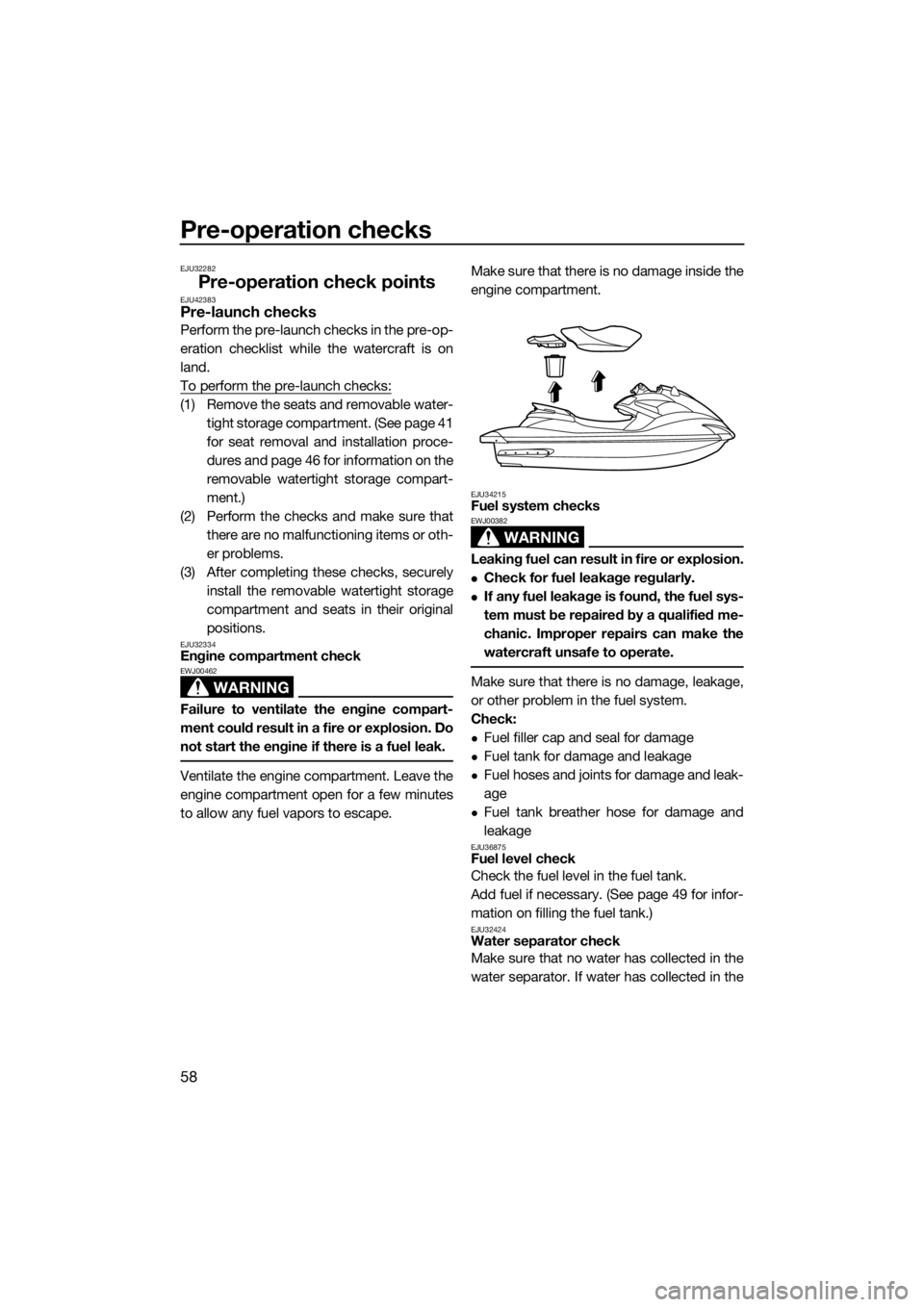
Pre-operation checks
58
EJU32282
Pre-operation check pointsEJU42383Pre-launch checks
Perform the pre-launch checks in the pre-op-
eration checklist while the watercraft is on
land.
To perform the pre-launch checks:
(1) Remove the seats and removable water-
tight storage compartment. (See page 41
for seat removal and installation proce-
dures and page 46 for information on the
removable watertight storage compart-
ment.)
(2) Perform the checks and make sure that
there are no malfunctioning items or oth-
er problems.
(3) After completing these checks, securely
install the removable watertight storage
compartment and seats in their original
positions.
EJU32334Engine compartment check
WARNING
EWJ00462
Failure to ventilate the engine compart-
ment could result in a fire or explosion. Do
not start the engine if there is a fuel leak.
Ventilate the engine compartment. Leave the
engine compartment open for a few minutes
to allow any fuel vapors to escape.Make sure that there is no damage inside the
engine compartment.
EJU34215Fuel system checks
WARNING
EWJ00382
Leaking fuel can result in fire or explosion.
Check for fuel leakage regularly.
If any fuel leakage is found, the fuel sys-
tem must be repaired by a qualified me-
chanic. Improper repairs can make the
watercraft unsafe to operate.
Make sure that there is no damage, leakage,
or other problem in the fuel system.
Check:
Fuel filler cap and seal for damage
Fuel tank for damage and leakage
Fuel hoses and joints for damage and leak-
age
Fuel tank breather hose for damage and
leakage
EJU36875Fuel level check
Check the fuel level in the fuel tank.
Add fuel if necessary. (See page 49 for infor-
mation on filling the fuel tank.)
EJU32424Water separator check
Make sure that no water has collected in the
water separator. If water has collected in the
UF3K72E0.book Page 58 Thursday, July 16, 2015 2:31 PM
Page 85 of 106
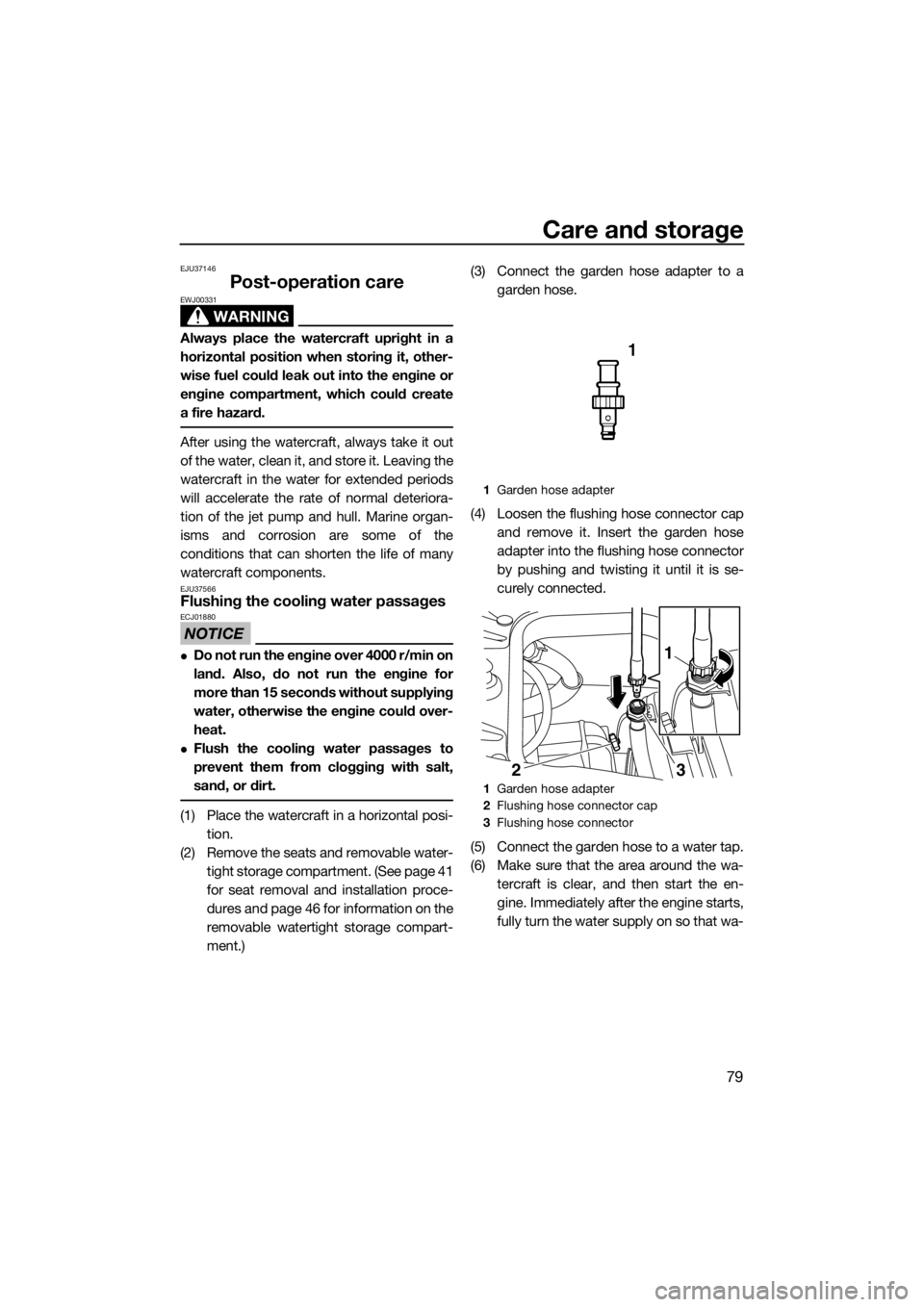
Care and storage
79
EJU37146
Post-operation care
WARNING
EWJ00331
Always place the watercraft upright in a
horizontal position when storing it, other-
wise fuel could leak out into the engine or
engine compartment, which could create
a fire hazard.
After using the watercraft, always take it out
of the water, clean it, and store it. Leaving the
watercraft in the water for extended periods
will accelerate the rate of normal deteriora-
tion of the jet pump and hull. Marine organ-
isms and corrosion are some of the
conditions that can shorten the life of many
watercraft components.
EJU37566Flushing the cooling water passages
NOTICE
ECJ01880
Do not run the engine over 4000 r/min on
land. Also, do not run the engine for
more than 15 seconds without supplying
water, otherwise the engine could over-
heat.
Flush the cooling water passages to
prevent them from clogging with salt,
sand, or dirt.
(1) Place the watercraft in a horizontal posi-
tion.
(2) Remove the seats and removable water-
tight storage compartment. (See page 41
for seat removal and installation proce-
dures and page 46 for information on the
removable watertight storage compart-
ment.)(3) Connect the garden hose adapter to a
garden hose.
(4) Loosen the flushing hose connector cap
and remove it. Insert the garden hose
adapter into the flushing hose connector
by pushing and twisting it until it is se-
curely connected.
(5) Connect the garden hose to a water tap.
(6) Make sure that the area around the wa-
tercraft is clear, and then start the en-
gine. Immediately after the engine starts,
fully turn the water supply on so that wa-
1Garden hose adapter
1Garden hose adapter
2Flushing hose connector cap
3Flushing hose connector
231
UF3K72E0.book Page 79 Thursday, July 16, 2015 2:31 PM
Page 89 of 106
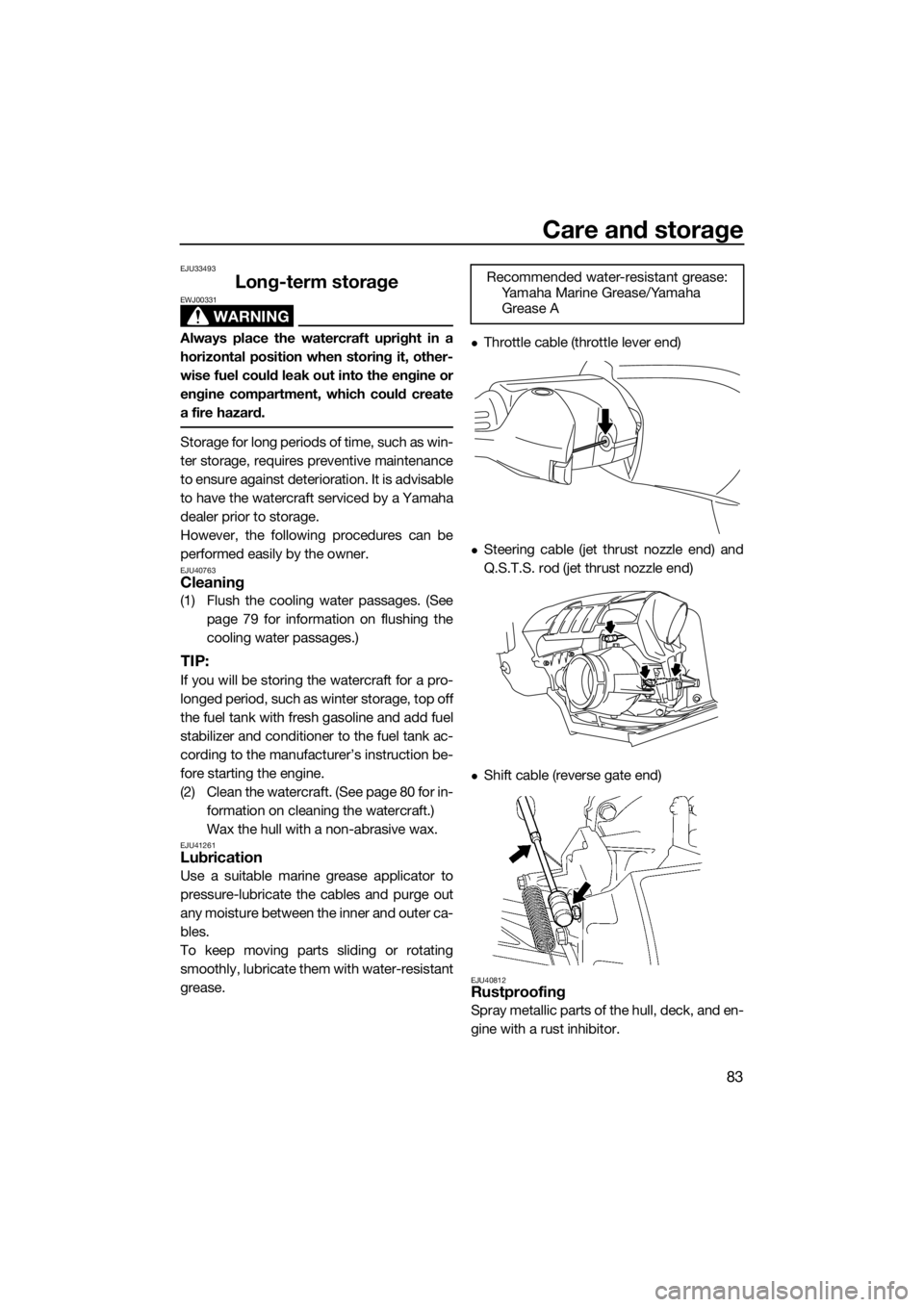
Care and storage
83
EJU33493
Long-term storage
WARNING
EWJ00331
Always place the watercraft upright in a
horizontal position when storing it, other-
wise fuel could leak out into the engine or
engine compartment, which could create
a fire hazard.
Storage for long periods of time, such as win-
ter storage, requires preventive maintenance
to ensure against deterioration. It is advisable
to have the watercraft serviced by a Yamaha
dealer prior to storage.
However, the following procedures can be
performed easily by the owner.
EJU40763Cleaning
(1) Flush the cooling water passages. (See
page 79 for information on flushing the
cooling water passages.)
TIP:
If you will be storing the watercraft for a pro-
longed period, such as winter storage, top off
the fuel tank with fresh gasoline and add fuel
stabilizer and conditioner to the fuel tank ac-
cording to the manufacturer’s instruction be-
fore starting the engine.
(2) Clean the watercraft. (See page 80 for in-
formation on cleaning the watercraft.)
Wax the hull with a non-abrasive wax.
EJU41261Lubrication
Use a suitable marine grease applicator to
pressure-lubricate the cables and purge out
any moisture between the inner and outer ca-
bles.
To keep moving parts sliding or rotating
smoothly, lubricate them with water-resistant
grease.
Throttle cable (throttle lever end)
Steering cable (jet thrust nozzle end) and
Q.S.T.S. rod (jet thrust nozzle end)
Shift cable (reverse gate end)
EJU40812Rustproofing
Spray metallic parts of the hull, deck, and en-
gine with a rust inhibitor.Recommended water-resistant grease:
Yamaha Marine Grease/Yamaha
Grease A
UF3K72E0.book Page 83 Thursday, July 16, 2015 2:31 PM